

Nanotechnology. Nanotechnology ("nanotech") is the manipulation of matter on an atomic, molecular, and supramolecular scale.
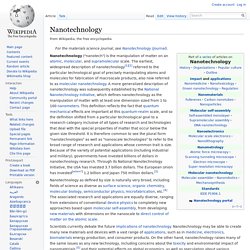
The earliest, widespread description of nanotechnology[1][2] referred to the particular technological goal of precisely manipulating atoms and molecules for fabrication of macroscale products, also now referred to as molecular nanotechnology. A more generalized description of nanotechnology was subsequently established by the National Nanotechnology Initiative, which defines nanotechnology as the manipulation of matter with at least one dimension sized from 1 to 100 nanometers.
This definition reflects the fact that quantum mechanical effects are important at this quantum-realm scale, and so the definition shifted from a particular technological goal to a research category inclusive of all types of research and technologies that deal with the special properties of matter that occur below the given size threshold.
List of nanotechnology organizations. From Wikipedia, the free encyclopedia This is a list of organizations involved in nanotechnology.

Government[edit] Advocacy and Information Groups[edit] Outline of nanotechnology. Nanotechnology – study of physical phenomena on the nanoscale, dealing with things measured in nanometres, billionths of a meter.
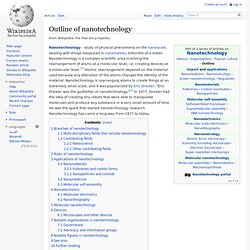
Nanotechnology is a complex scientific area involving the rearrangement of atoms at a molecular level, i.e. creating devices at a molecular level.[1] Atomic rearrangement depends on the material used because any alteration of the atoms changes the identity of the material. Nanotechnology is rearranging atoms to create things at an extremely small scale, and it was popularized by Eric Drexler: "Eric Drexler was the godfather of nanotechnology. "[2] In 1977, Drexler had the idea of creating tiny robots that were able to manipulate molecules and produce any substance in a very small amount of time. He was the spark that started nanotechnology research. Nanotechnology in fiction. The use of nanotechnology in fiction has attracted scholarly attention.[1][2][3][4] The first use of the distinguishing concepts of nanotechnology was "There's Plenty of Room at the Bottom", a talk given by physicist Richard Feynman in 1959.

K. Eric Drexler's 1987 book Engines of Creation introduced the general public to the concept of nanotechnology. Since then, nanotechnology has been used frequently in a diverse range of fiction, often as a justification for unusual or far-fetched occurrences featured in speculative fiction.[5] Notable examples[edit] Literature[edit] In 1881 the Russian writer Nikolai Leskov wrote The Tale of Cross-eyed Lefty from Tula and the Steel Flea, which included the concept of text that can be seen only through a microscope at 5,000,000 times magnification.[6] In his 1956 short story The Next Tenants, Arthur C.
Neal Stephenson's 1995 novel The Diamond Age is set in a world where nanotechnology is commonplace. J. Film and television[edit] In the 2009 film G.I. Regulation of nanotechnology. Because of the ongoing controversy on the implications of nanotechnology, there is significant debate concerning whether nanotechnology or nanotechnology-based products merit special government regulation.

This mainly relates to when to assess new substances prior to their release into the market, community and environment. Nanotechnology refers to an increasing number of commercially available products – from socks and trousers to tennis racquets and cleaning cloths. Such nanotechnologies and their accompanying industries have triggered calls for increased community participation and effective regulatory arrangements.[1] However, these calls have presently not led to such comprehensive regulation to oversee research and the commercial application of nanotechnologies,[2] or any comprehensive labeling for products that contain nanoparticles or are derived from nano-processes. Managing risks: human and environmental health and safety[edit] Democratic governance[edit] Many[who?] List of nanotechnology applications. The 2000s has seen the beginnings of the applications of nanotechnology in commercial products, although most applications are limited to the bulk use of passive nanomaterials.
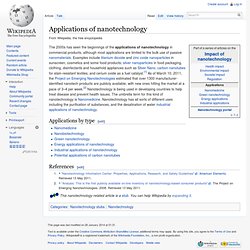
Examples include titanium dioxide and zinc oxide nanoparticles in sunscreen, cosmetics and some food products; silver nanoparticles in food packaging, clothing, disinfectants and household appliances such as Silver Nano; carbon nanotubes for stain-resistant textiles; and cerium oxide as a fuel catalyst.[1] As of March 10, 2011, the Project on Emerging Nanotechnologies estimated that over 1300 manufacturer-identified nanotech products are publicly available, with new ones hitting the market at a pace of 3–4 per week.[2] Nanotechnology is being used in developing countries to help treat disease and prevent health issues.
Impact of nanotechnology. The impact of nanotechnology extends from its medical, ethical, mental, legal and environmental applications, to fields such as engineering, biology, chemistry, computing, materials science, and communications.
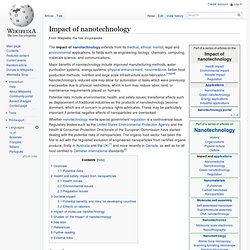
Major benefits of nanotechnology include improved manufacturing methods, water purification systems, energy systems, physical enhancement, nanomedicine, better food production methods, nutrition and large scale infrastructure auto-fabrication. [vague] Nanotechnology's reduced size may allow for automation of tasks which were previously inaccessible due to physical restrictions, which in turn may reduce labor, land, or maintenance requirements placed on humans.
Potential risks include environmental, health, and safety issues; transitional effects such as displacement of traditional industries as the products of nanotechnology become dominant, which are of concern to privacy rights advocates. Whether nanotechnology merits special government regulation is a controversial issue. History of nanotechnology. The history of nanotechnology traces the development of the concepts and experimental work falling under the broad category of nanotechnology.
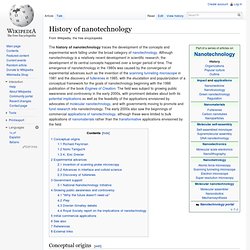
Although nanotechnology is a relatively recent development in scientific research, the development of its central concepts happened over a longer period of time. The emergence of nanotechnology in the 1980s was caused by the convergence of experimental advances such as the invention of the scanning tunneling microscope in 1981 and the discovery of fullerenes in 1985, with the elucidation and popularization of a conceptual framework for the goals of nanotechnology beginning with the 1986 publication of the book Engines of Creation. Conceptual origins[edit] Richard Feynman[edit] The American physicist Richard Feynman lectured, "There's Plenty of Room at the Bottom," at an American Physical Society meeting at Caltech on December 29, 1959, which is often held to have provided inspiration for the field of nanotechnology. Norio Taniguchi[edit] K. K.